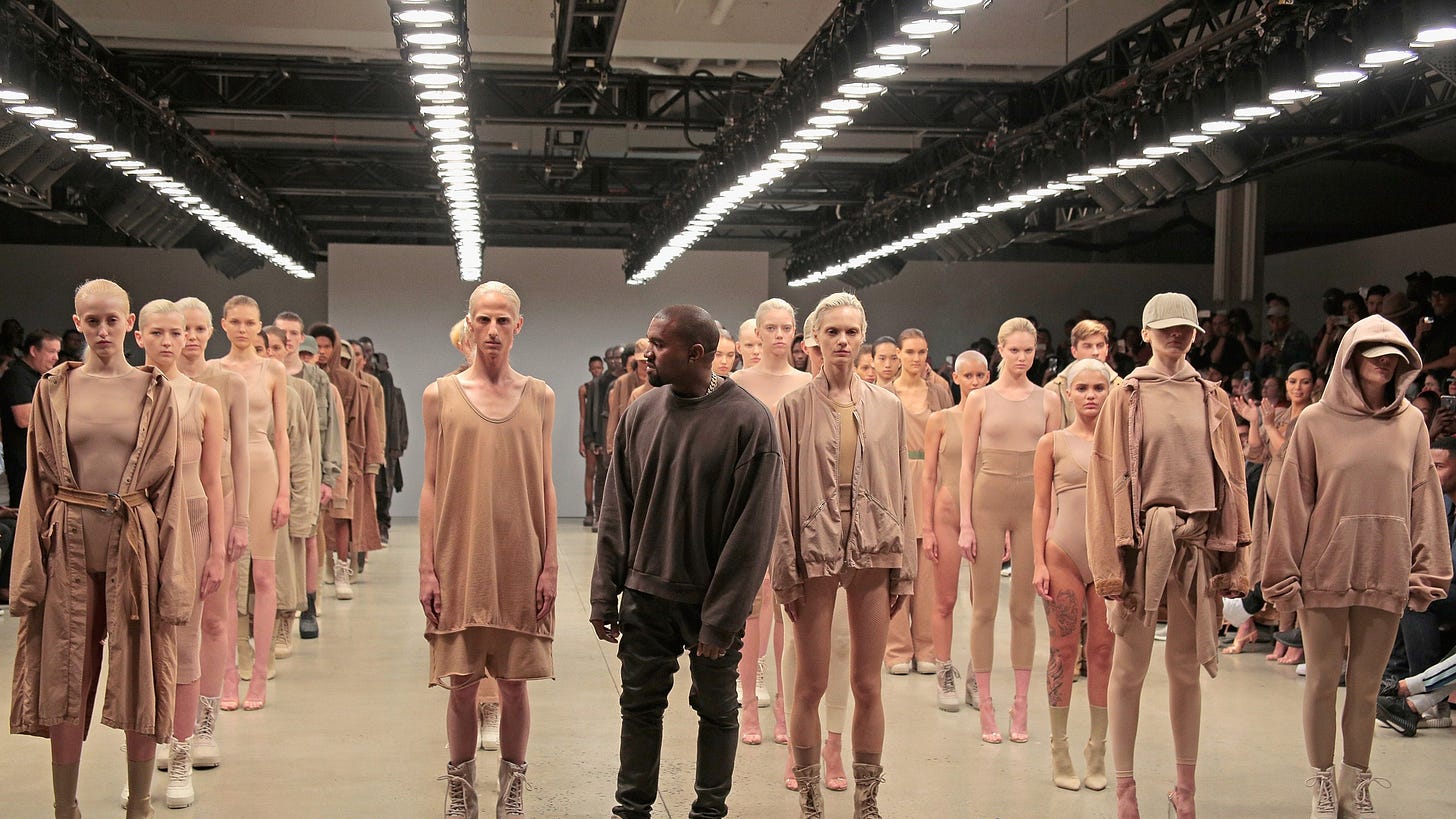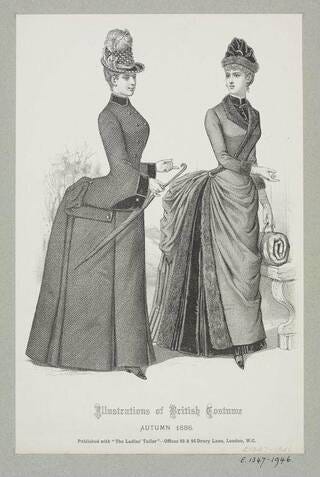BBL Fashion, Wealth Signaling, and Kanye West’s Obsession with the ‘Perfect’ Body
A look at BBL fashion, the Yeezy aesthetic, and why Kanye West is running out of ways to shock us.
In 2014, Kim Kardashian coined a phrase when she donned an updo and baby oil for Paper Magazine. The phrase? ‘Break the internet’. Nearly eleven years later, Bianca Censori arrived at the 2025 Grammys in a sheer, presumably tulle dress with the mesh so fine that only the hem’s outline revealed it was even there. While Censori’s look sparked conversation online, it failed to reach the same level of cultural impact as Kardashian’s moment. Yet both women had one thing in common - their stylist.
For the Paper Magazine shoot, Kanye West was not the stylist (that credit goes to Alex Aikiu), but during his marriage to Kardashian, he had an undeniable influence on her wardrobe and the reality star has stated numerous times that he was her stylist throughout their marriage, and would pre-approve the clothing and styling on shoots she partook in. He styled her in many sheer and risqué looks during their marriage, for both pap walks and editorials.

He played a significant role in shaping her style, favouring sheer, body-conscious designs. The KarJenners - particularly Kim - became fixtures in West’s Yeezy campaigns and runway shows. But as both his marriage and partnership with Adidas unraveled, so did Yeezy’s mainstream dominance. Following his antisemitic tirades on Instagram and then-Twitter-now-X, West was dropped by Adidas and took Yeezy to be independent. Now, his primary creative focus seems to be styling his new wife, Bianca Censori.
Many of Censori’s looks feel like reruns of past Yeezy aesthetics - skin tight, sheer, and barely there. This isn’t inherently a flaw; designers often refine and revisit their signature styles. In some ways, a slower fashion cycle is a positive shift. But rather than evolving his work, West appears more interested in shaping an image - crafting a model, rather than designing garments.
Female Body Trends in Fashion
In 2015, Karl Lagerfeld declared that the female waist would be the next major fashion trend, more specifically saying that the midriff was the “new cleavage”. The idea of a body part being ‘in fashion’ was mocked at the time, with some rightly criticising it, but yet in the decade that’s followed, we saw the rise of ‘BBL fashion’ - a version of what Largerfeld predicted; composed of an exgerated hourglass silhouette, emphasizing a small waist, wide hips, and a prominent rear.
This wasn’t the first time surgical enhancements influenced beauty trends. The early 2000s were dominated by breast augmentation, while the ’90s idolised heroin chic - an extreme thinness unattainable and unhealthy for most. Body trends often reflect broader social and economic shifts1, and what we can see is that these trends usually share is an illusion of wealth. In the past, tanned skin was a sign of lower class labour, having to work outside under the sun - until Coco Chanel returned from a yacht trip with a sun kissed glow, making tans a marker of leisure and affluence. Similarly, in the ’90s, thinness was a stark contrast to the rise of cheap fast food. By being thin, it showed that you could either a) afford to have better food and/or b) had the discipline not to eat cheap fast food.
This gradually led to the rise of cosmetic enhancements we see today. While it's not solely about wealth, it’s impossible to ignore that wealth signaling plays a significant role in shaping beauty standards, both consciously and subconsciously.
Long before modern cosmetic surgery, fashion itself sculpted the female form. Petticoats, bustles and layers of crinoline exaggerated proportions, creating the illusion of a smaller waist and fuller hips.
With the gradual rise of surgical enhancements, the decline of puritanical values and dress codes, and, somewhat ironically, the progress of women’s rights, the body itself has now become the fabric - molded and altered to conform to the prevailing aesthetic.
BBL Fashion and Kanye West’s Impact
For the past decade, the BBL (Brazilian Butt Lift) has been one of the most sought after cosmetic procedures, embraced by influencers and celebrities alike. The surgery transfers fat from ‘undesirable’ areas and placed around the rear to create an exaggerated hourglass shape. When done well, the results can be striking; when done poorly, the ‘diaper butt’ or ‘turkey leg’ effect (where the upper thighs and legs do not match the weight of the rear, causing an uncanny valley effect to the body) becomes unmistakable.
BBL fashion is often associated with fast-fashion brands like Fashion Nova and Shein, whose designs often cater to extreme curves. It is relying on the body to make the clothing look good, rather than the clothing be constructed well. This isn’t just a fast fashion issue - many luxury brands have also deprioritised tailoring and fabric quality in line with these new trends (instead opting for cheap labour and other cost-cutting measures), making it sometimes difficult to distinguish a designer piece from something off the high street.
Kanye West has been a key promoter of this aesthetic, through his Yeezy line, which featured skin tight, nude coloured leggings and tops, occasionally paired with oversized sweatshirts. And this isn't a criticism of Kanye, but rather an acknowledgment of how his blending of underwear and outerwear in the 2010s redefined fashion. While the concept of underwear as outerwear has come and gone, Yeezy's minimalist, body hugging, skin toned designs and casual underwear as outer layers became widely adopted and remain influential today. In fact, I recently saw a friend wearing a chocolate bodysuit top that closely resembled a Skims garment, which of course, takes major inspiration from Yeezy’s earlier collections.

But it has been over a decade since West has launched this particular aesthetic, and many fast fashion brands can easily replicate a nude top or leggings. Yeezy has lost its novelty. And no longer having the manufacturing strength he had while with Adidas, Yeezy has not progressed in new aesthetics, or the technical know how for garment construction. In fact, West seems to be spearheading a dramatic veer into the aesthetic he became a fashion star of. Tight and nude.
While West is often seen in casual oversized athleisure, his wife alongside him, Bianca Censori, wears increasingly revealing outfits. From nude tights to many, many, sheer tops, to a transparent rain poncho with nothing underneath, Censori stepping out in nothing but a completely sheer dress was not shocking, or, as West may have wanted most - provocative. Instead, it was tired, and worst, boring.
When Provocation Becomes Predictable
There was a time when a ‘naked dress’ felt shocking. Rose McGowan’s nearly nude 1998 VMAs look was a bold statement - a first of its kind and one that, as she later revealed, was a personal act of reclaiming her body after assault. Marilyn Monroe’s famous crystal embellished gown, dyed to match her skin tone, created an illusion of nudity while draped in diamonds. More recently, designers have played with the concept in artistic ways - from Elle Fanning’s Balmain glass-like gown to Taylor Russell’s Loewe wood-like corset, both for the 2024 Met Gala. Even famous provocateur, Alexander McQueen’s controversial Highland Rape collection had a purpose beyond shock value, addressing themes of historical oppression.
But Censori’s look? We’ve seen it before - not just from her, but from countless others. A wealthy, fully clothed man standing beside a silent woman (who looks eerily like his ex wife) in near nudity isn’t avant-garde; it’s tired. While some have speculated that West is exerting control over his wife’s image and abusing her (due to the fact we constantly hear him speak, but have never heard her), it seems more likely that she is simply another in a long line of yes men (though that does not take away from West treating her publically as nothing more than an accessory) - molded into his vision and complicit in his attempts to remain relevant. She also was only part naked, in the sense that her hair and makeup was flawless, and her body probably tanned to hide any scars and stretchmarks she may have. A perfect doll, a cumulation of the perfect body type advertised to women for the past decade.
A TikTok I saw recently summed it up perfectly: If West truly wanted to be radical, he wouldn’t just strip away the clothing - he would strip away the polish. Imagine Censori with no makeup, undone hair, and a bush (I’m not talking about on her head). That would be subversive. Instead, what we got was an exhausted rehash of a look that no longer shocks or inspires, a polished perfection we are so used to seeing on screens, but not nude in a way that’s truly groundbreaking.
Following the Grammys stunt, West took to X with another antisemitic rant and announced a Yeezy x Sean John collaboration - aligning himself with Diddy - who, in case you missed it, is currently facing sex trafficking charges. At this point, it’s clear that as much as fashion has moved on from West, he has moved on from fashion. Instead, he’s clinging to shock tactics, desperately seeking the attention he once commanded through the talent he actually possesed. It’s a disappointing trajectory for someone who once reshaped the industry, now reduced to chasing headlines for all the wrong reasons.
If you’d like to read more about body trends and sociology, this paper by Phoebe R. Apeagyei looks at the social commodification of being skinny, while this paper by Dr. Neelam looks at social dynamics and beauty trends.







